New publications
Plants
Jasmine
Last reviewed: 29.06.2025
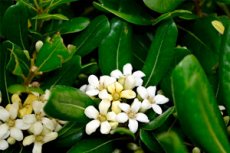
Jasmine (Jasminum) is a genus of perennial plants in the olive family (Oleaceae), known for its fragrant flowers, which includes about 200 species. It is primarily found in tropical and subtropical regions around the world. Jasmine species can be shrubs or vines, making them suitable for ornamental plantings and the creation of green walls and hedges. The flowers of jasmine are characterized by a strong aroma, often used in the perfume industry. The plant's leaves are typically simple, oval, or elongated, with a glossy surface.
Jasmine can be either a houseplant or a garden plant, depending on the species and climate conditions. In temperate climates, jasmine is often grown in pots to be moved indoors during the winter months. In warmer countries, it can grow in the ground and adorn many decorative areas.
Etymology
The name "jasmine" comes from ancient languages and has a rich cultural history associated with this fragrant flower. Let's look at the origin and development of this name in more detail.
Origin from Persian:
The word "jasmine" comes from the Persian word "یاسمن" (yāsaman), which denotes a fragrant flower known for its beautiful and aromatic blossoms. The Persian "یاسمن" entered the Arabic language as "ياسمين" (yasmin), retaining a similar meaning.
Spread through the Arabic language:
The Arabic "ياسمين" (yasmin) spread into other languages, including Turkish ("yasemin") and Ottoman, which facilitated its further borrowing into European languages. Through Arab trade and cultural contacts, the term "yasmin" entered European languages.
Path into European languages:
In English, the word "jasmine" appeared as a result of the adaptation of the Arabic "yasmin." The English "jasmine" became the standard name for this flower. In Russian, the term "jasmine" was borrowed from Western European languages, most likely through French or German intermediaries, where the flower was already known by a name similar to the English "jasmine."
Meaning and symbolism:
Jasmine is associated with beauty, purity, and fragrance. In various cultures, this flower has symbolic meanings: in some countries, it is considered a symbol of love and romance, while in others, it symbolizes purity and innocence. In literature and art, jasmine is often mentioned as a symbol of refinement and elegance.
Scientific name:
In biological classification, jasmine belongs to the genus Jasminum of the Oleaceae family. The genus name also comes from the Latin "jasmine," which, in turn, has the same roots as the Russian "jasmine."
Life form
Jasmine plants can be shrubs or vines, depending on the species. Many jasmine species have woody stems that can cover large areas. Vines like the Arabian jasmine (Jasminum sambac) can reach 3-5 meters in height, climbing over supports or other plants, making them ideal for vertical gardening.
Shrubs like common jasmine (Jasminum officinale) have a compact form and are often used in garden compositions. These plants are well-suited for creating hedges, borders, and ornamental shrubs. In both cases, jasmine prefers sunny spots and moderately fertile soil.
Family
Jasmine belongs to the olive family (Oleaceae), which includes about 30 genera and 600 species of plants, including olive trees, forsythias, privets, and others. The family is known for its diversity, including both trees and shrubs commonly used in gardening and landscaping.
Within the olive family, other notable plants include privet, widely used in decorative landscaping, and the olive tree, a source of valuable oil. Jasmine attracts attention with its ornamental flowers and intense fragrance.
Botanical characteristics
Jasmine is a plant with soft, flexible stems that can be either vine-like or shrub-like. The leaves are usually leathery, oval or elongated, and have a glossy surface. The flowers are typically white or yellow, arranged in clusters, and have a rich, pleasant fragrance that becomes more pronounced in the evening.
The fruit of jasmine is usually a berry or capsule containing several seeds. The plant typically blooms in spring and summer, though the duration of blooming can vary depending on the species and growing conditions.
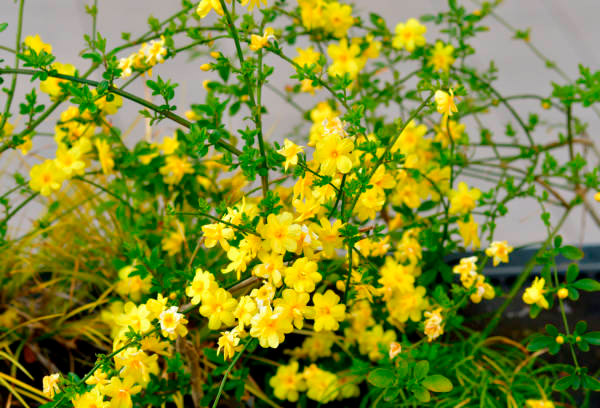
Jasminum mesnyi
Chemical composition
Jasmine is known for its rich chemical composition, which includes essential oils, flavonoids, alkaloids, saponins, and organic acids. The essential oils found in the flowers have distinct aromatic properties and are used in the perfume and cosmetics industries. Jasmine oils are also used in aromatherapy for their calming and relaxing effects.
Flavonoids found in the plant’s leaves and flowers have antioxidant properties and help strengthen the immune system. Research has shown that jasmine components have anti-inflammatory and antimicrobial effects, making the plant beneficial in folk medicine.
Origin
Jasmine is native to the tropical and subtropical regions of Asia, Africa, and Europe. Many species, such as Arabian jasmine (Jasminum sambac), originate from Southeast Asia, while others, like common jasmine (Jasminum officinale), come from the Mediterranean. In nature, these plants are found in forests, open areas, and mountainous regions, where they can thrive in either shade or sunlight.
Since ancient times, jasmine has been cultivated in gardens and used as both a decorative and aromatic plant. Today, jasmine is widespread around the world, especially in warm climates, where it is grown both in the ground and in greenhouses.
Ease of growing
Jasmine is a relatively low-maintenance plant that can thrive in various conditions if basic requirements are met. It prefers sunny locations and fertile, well-drained soil. In temperate climates, jasmine is often grown in pots so that it can be moved indoors during the winter.
To grow successfully, jasmine requires regular watering and feeding, as well as protection from strong winds and cold temperatures. In winter, the plant needs less water and protection from frost.
Species and varieties
There are around 200 species of jasmine, with several varieties being particularly popular as ornamental plants. Common jasmine (Jasminum officinale) is known for its white flowers, while Arabian jasmine (Jasminum sambac) is famous for its fragrant blooms, often used in perfume production.
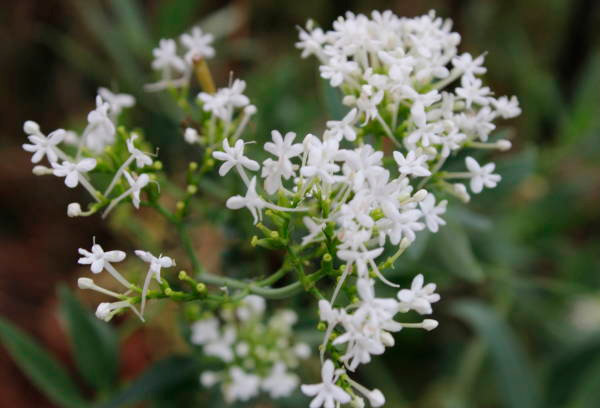
Jasminum azoricum
Other species, such as Jasminum azoricum and Jasminum nitidum, are also popular due to their attractive flowers and fragrance.
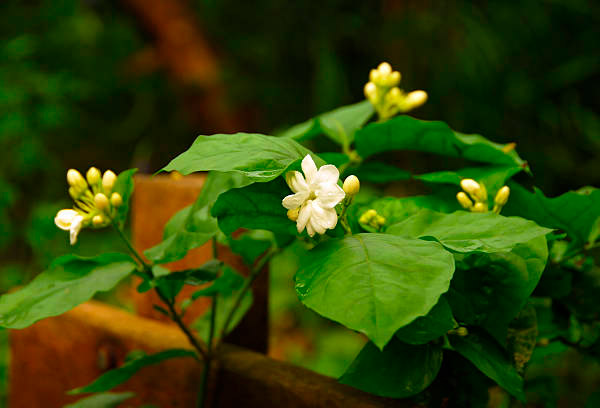
Jasminum sambac
Jasmine varieties can differ in flower color, size, and shape. Some varieties have yellow flowers, such as Jasminum mesnyi, while others may be creeping vines or compact shrubs, making them suitable for various landscaping styles.
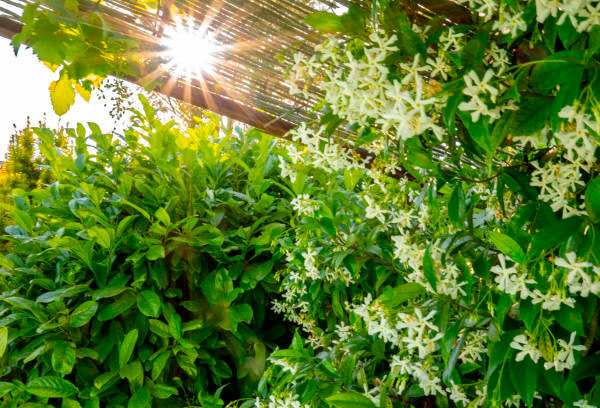
Jasminum officinale
Size
Jasmine can vary in size depending on the species. Vining types, such as Jasminum sambac, can reach 3-5 meters in length, requiring support or climbing structures for growth. Shrub types, such as Jasminum officinale, usually have a height of 1 to 3 meters, depending on growing conditions and pruning.
The plant's size also depends on how it is grown: in containers, jasmine will remain compact, while when planted in the ground, it can grow significantly larger.
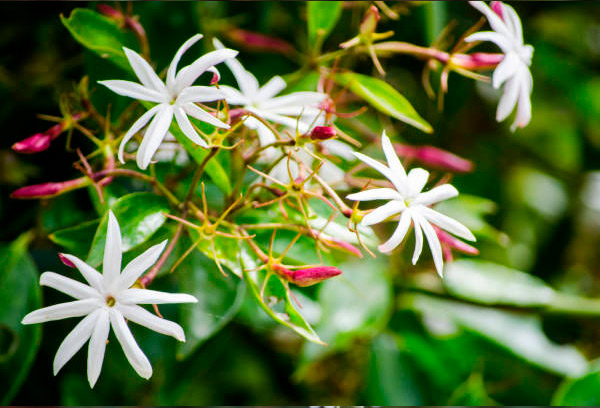
Jasminum nitidum
Growth rate
The growth rate of jasmine depends on its growing conditions. Under optimal conditions (warmth, adequate light, and regular watering), jasmine can grow fairly quickly, especially vine types. Over a season, the plant can grow several centimeters, and with proper care, it may begin to bloom within two or three years of planting.
When growing jasmine in pots, the growth rate may be somewhat slower due to root restriction, but regular feeding and substrate changes can encourage active growth.
Lifespan
The lifespan of jasmine depends on the species and growing conditions. On average, the plants can live from 5 to 20 years, with the best results achieved with regular pruning and proper care. Some jasmine species, such as Jasminum sambac, can live much longer, especially when grown in favorable climate conditions and protected from frost.
With good care and favorable living conditions, jasmine can delight its owners for many years, becoming a beautiful addition to gardens or homes.
Temperature
Jasmine prefers warm climates and cannot withstand frost, making it ideal for growing in regions with mild climates. The optimal temperature for jasmine growth during the spring-summer period is 18-24°C. In winter, the plant can tolerate temperatures as low as 10-15°C but should be kept indoors, protected from cold drafts. When grown in pots, it is important to avoid significant temperature fluctuations, as this can negatively affect the plant’s health.
When growing jasmine outdoors in areas with cold winters, protection from frost is necessary. This can be done by digging up the plants or covering them during winter. It is also important to note that excessively high temperatures in summer can cause stress to the plant, especially if the humidity is low.
Humidity
Jasmine prefers moderately humid air and does not tolerate dryness, especially in winter when indoor heating can significantly dry out the atmosphere. To maintain optimal humidity, regular leaf spraying or the use of humidifiers is recommended, particularly in homes with central heating. This will help prevent the drying and wilting of leaves and promote plant growth.
However, it is important to remember that excessive moisture in the soil can lead to root rot. Therefore, it is crucial to maintain a balance between air humidity and watering. For most jasmine species, it is recommended to keep the air humidity at 50-60%, which is optimal for growth and flowering.
Lighting and placement in the room
Jasmine is a sun-loving plant that requires plenty of sunlight for proper growth and flowering. The best conditions for it are well-lit places where the plant receives sunlight for 4-6 hours a day. Indoors, jasmine is best placed on windowsills facing south or west, as these locations provide sufficient light.
However, during hot summer months, it is important to avoid direct sunlight at midday to prevent overheating and leaf burn. If your home does not provide enough natural light, artificial lighting can be used to provide the plant with the necessary conditions for photosynthesis and blooming. It is also important to remember that for vining jasmine varieties, supports are necessary for the plant to climb, creating a living green wall or hanging beautifully.
Soil and substrate
Jasmine requires light and well-drained soil for optimal growth. The ideal soil mix should consist of equal parts of humus, peat, sand, and perlite. Peat helps retain the necessary moisture, while sand and perlite ensure good drainage, and humus improves the soil’s nutritional content and structure. This mix allows the plant’s roots to breathe and prevents waterlogging, which is critical for the health of jasmine.
The soil’s acidity should be slightly acidic, with a pH level between 5.5 and 6.5. It is important to monitor the acidity, as excessive alkalinity or high acidity can affect nutrient absorption by the plant. To improve soil structure, it is recommended to add organic fertilizers like compost and regularly refresh the substrate during repotting.
Watering
In the summer, jasmine should be watered regularly but moderately. The plant prefers moist soil but does not tolerate water stagnation, so it is important to ensure that water does not remain in the saucer. During the summer, watering should be abundant, especially in hot weather when the plant is actively growing and flowering. It is important to remember to water only when the top layer of the soil has dried slightly to avoid root rot.
Winter watering is significantly reduced. During this time, the plant enters a dormant period, and excess moisture can lead to root rot. Jasmine should be watered less frequently, ensuring only light moisture to prevent the soil from drying out. It is important that the plant is not placed in drafts and is protected from cold air, as this helps prevent stress caused by sharp temperature fluctuations.
Fertilizing and feeding
Jasmine needs regular fertilization to stimulate growth and flowering. During the spring and summer when the plant is actively growing, you can use balanced fertilizers for flowering plants. It is optimal to apply fertilizers twice a month, alternating between organic (such as liquid compost) and mineral fertilizers rich in phosphorus and potassium, which promote strong stems and vibrant flowers.
From autumn to winter, fertilization stops as jasmine rests during this period. It is important to avoid over-fertilizing, as this can cause excessive leaf growth at the expense of flowering. Both granular and liquid fertilizers can be used, with liquid fertilizers spreading evenly over the soil during watering.
Propagation
Jasmine can be propagated through both cuttings and seeds. Cuttings are typically taken in spring or early summer. To propagate, cut healthy shoots about 10–15 cm long, remove the lower leaves, and root them in a mix of sand and peat while maintaining a temperature of around 20°C and a humidity level of 80%. After 2-3 weeks, the cuttings usually develop roots, after which they can be transplanted into separate pots.
Growing jasmine from seeds requires more time and patience. The seeds should be soaked in water for 24 hours before being planted in the prepared substrate, ensuring a consistent temperature of 20–22°C. Germination can take from several weeks to several months. Young plants should be carefully repotted into larger pots as they grow.
Flowering
Jasmine typically begins to bloom in the spring and summer, usually from May to September. The flowers can be white, pink, or yellow, depending on the variety. They have a pleasant, often sweet fragrance, which makes jasmine a popular decorative plant, especially for growing indoors. Flowering can last from several weeks to several months, depending on the variety and care conditions.
To stimulate flowering, jasmine requires adequate lighting and regular feeding, particularly during active growth. A lack of flowers can be due to insufficient light or nutrients. Some jasmine varieties, such as Jasminum sambac, can bloom multiple times a year if the growing conditions are optimal.
Seasonal features
Jasmine is a perennial plant with specific seasonal care needs. In summer, it requires more sunlight, warm temperatures, and regular watering. During this time, the plant grows and blooms actively, requiring frequent feedings and protection from direct sunlight to prevent leaf burns. In winter, the plant should be in a dormant state, with minimal watering and no fertilization. This period also requires protection from low temperatures.
To provide comfortable winter conditions, jasmine can be moved to a cooler but bright place where the temperature remains between 10-15°C. During this time, the plant will not bloom and needs rest to prevent stress and aid recovery for the next growing season.
Care features
Jasmine does not require complex care but needs regular attention. It is important to maintain optimal humidity levels and monitor watering schedules. Sunlight and periodic feeding not only promote the plant’s health but also enhance its ornamental qualities. However, excessive watering or the use of incorrect fertilizers can cause problems such as root rot or a lack of flowers.
Periodically trimming old and damaged branches improves the plant’s appearance and stimulates new growth, which affects its fullness and flowering. Pruning is best done at the end of winter or early spring to prepare the plant for the new growing season.
Care at home
At home, jasmine requires regular watering, but it is important to avoid water stagnation in the saucer. Pots should have good drainage, and the soil should be well-aerated. In the summer, watering should be more frequent, especially on hot days, while in winter, watering should be reduced to prevent root rot.
In addition, jasmine needs regular pruning to maintain its shape and stimulate growth. Periodically removing wilted flowers and damaged leaves improves the plant’s appearance and promotes healthy development. It is also important to monitor air humidity, especially in winter when the air in the room may be too dry.
Repotting
Jasmine should be repotted every 1-2 years to provide enough space for root growth. When choosing a pot, ensure it is 2–3 cm wider than the previous one to allow the roots to develop freely. Both plastic and ceramic pots are suitable for jasmine. Ceramic pots are more aesthetic but require more careful watering to prevent soil drying out.
The best time to repot is early spring, before the active growth period begins. This allows the plant to adapt to the new conditions and accelerates recovery after repotting. Be sure to handle the roots gently to avoid damaging them, and use fresh, well-prepared substrate.
Pruning and shaping the crown
Pruning jasmine is necessary to maintain a compact plant form and stimulate flowering. Remove old, damaged, and dried stems, and pinch the tips of young shoots to encourage branching. If necessary, the crown can be shaped into a small tree or a bush, depending on the variety.
To stimulate abundant flowering, pruning should be done in accordance with the dormancy period, ideally at the end of winter or early spring. This will allow the plant to produce new shoots that will bloom in the next season.
Common problems and solutions
One of the main issues with growing jasmine is the appearance of yellow leaves, which may be due to nutrient deficiencies, especially nitrogen, or improper watering. The plant may also suffer from root rot if overly moist or poorly-drained soil is used. To prevent these problems, it is essential to monitor the soil condition and water the plant correctly.
Another common issue is pests such as spider mites, aphids, or whiteflies. To combat these, you can use special insecticides or homemade remedies like garlic or soap solutions. Regular monitoring of the plant is important, and prompt action should be taken at the first signs of infestation.
Pests
The main pests of jasmine are spider mites, aphids, whiteflies, and mealybugs. Spider mites appear when the air is too dry and manifest as fine webs on the undersides of leaves, as well as yellow spots on the leaves. To prevent this pest, regularly mist the plant and maintain optimal humidity.
Aphids and whiteflies can cause significant damage by sucking sap from leaves and flowers. Insecticides or soap solutions can be used to combat them. Always monitor the plant's condition and take action at the first signs of infestation.
Air purification
Jasmine is not only an ornamental plant but also an effective air purifier. It can absorb harmful substances such as formaldehyde, benzene, and other volatile organic compounds, improving air quality in indoor spaces. Due to its air-purifying ability, jasmine is ideal for offices and homes, where it will not only decorate the interior but also create a healthy atmosphere.
Safety
Jasmine is not a toxic plant, but its fragrance may cause allergic reactions in some individuals. Contact with the plant or its flowers may result in skin irritation or respiratory issues for sensitive individuals. It is important to monitor health when growing jasmine and avoid contact with children and pets, especially if anyone in the household suffers from allergies.
Wintering
In winter, jasmine requires special care, as the plant should rest during this period. Reducing the temperature to 10–15°C helps jasmine enter dormancy and prevent excessive leaf growth. During this time, watering should be reduced, and no fertilization should occur. Wintering also requires providing sufficient light to prevent the plant from suffering from light deficiency.
Health benefits
Jasmine has many beneficial properties, which are valued in aromatherapy and traditional medicine. Jasmine extract is used to calm the nervous system, relieve stress, and improve mood. The fragrance of jasmine has a relaxing effect, helping to reduce anxiety and improve sleep quality.
Use in traditional medicine or folk remedies
Jasmine is used in folk medicine to prepare infusions and decoctions that have antiseptic and calming effects. Jasmine flower infusions are used to treat colds, headaches, and insomnia. Jasmine also aids digestion and strengthens the immune system.
Use in landscape design
Jasmine is a popular plant in landscape design due to its decorative qualities and fragrance. It is used to create green hedges, live fences, as well as to decorate pergolas and gazebos. Vine-like jasmine varieties are ideal for vertical gardening, creating living walls that beautify a garden and serve as natural shade.
Compatibility with other plants
Jasmine grows well in the company of many plants. It is suitable for combinations with other flowering plants such as roses, lavender, and geraniums, as well as shrubs and small trees. However, avoid planting jasmine near plants that require significantly different care conditions, such as those that need direct sunlight or dry soil. Additionally, some plants may inhibit the growth of jasmine due to competition for nutrients.
Conclusion
Jasmine is not only a beautiful but also a beneficial plant, making it ideal for growing indoors and in garden plots. Even a beginner gardener can handle its care if the basic growing rules and optimal conditions are followed. With proper care, jasmine will delight with its wonderful fragrance and vibrant flowers for many years.
